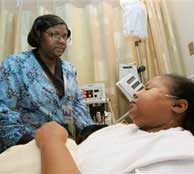This is the VOA Special English Health Report.
Last week, researchers in the United States reported curing nine adults with sickle cell disease. Ten patients in all were treated in a study with donated bone marrow. The healthy marrow causes new blood cells to form.
Sickle cell disease, also called sickle cell anemia, is a genetic condition that deforms red blood cells. They become sticky and harden into the shape of the letter C, like a sickle, a hand tool with a curved blade.

The deformed cells block blood vessels and cut off the flow of oxygen to tissue in the body. People with sickle cell disease can suffer severe pain, bacterial infections and the death of tissue.
In other studies, bone marrow transplants cured severe sickle cell disease in almost 200 children. Doctors first used chemicals to destroy the children's own marrow, then replaced it with healthy marrow.
However, doctors have considered this treatment too risky for adults with the disease. Their major organs are already too damaged to have all their bone marrow destroyed.
So for the ten patients in the study, doctors used a low amount of radiation to destroy only some of their marrow. Then the patients received healthy marrow. There was enough space in the bone for the healthy marrow to start producing new red blood cells.
The researchers say all ten patients remain alive two and a half years after the treatment, and the disease has disappeared in nine of them.
Marrow is a soft, spongy tissue inside bones. Doctors can collect it with a needle. But people who donate marrow must first have tests to make sure they are a good match for the patient.
The New England Journal of Medicine published the study. John Tisdale at the National Institutes of Health was the lead investigator. He says other uses for the treatment are also likely to be found.
Black people in Africa are the huge majority of those with sickle cell disease. About 200,000 cases are found in African children every year. About 80,000 people have it in the United States.
A study published in September in the Lancet said antibacterial vaccines could save the lives of children with sickle cell in Africa. The study pointed out that many children die before they are even identified as having the disease. They die from bacterial infections for which there are new vaccines. But these vaccines are costly and available mainly in wealthy countries.
And that's the VOA Special English Health Report, written by Caty Weaver. For more health news, go to voaspecialenglish.com. I'm Steve Ember.
sickle cell: an abnormal, crescent-shaped red blood cell that results from a single change in the amino acid sequence of the cell's hemoglobin, which causes the cell to contort, especially under low-oxygen conditions 镰状红细胞
anemia: a pathological deficiency in the oxygen-carrying component of the blood, measured in unit volume concentrations of hemoglobin, red blood cell volume, or red blood cell number 贫血
sickle: an implement having a semicircular blade attached to a short handle, used for cutting grain or tall grass 镰刀
Related stories:
80 kids suffer lead poisoning
Blood touts face longer jail terms
Looking for new ways to fight Malaria
A combination pill lowers blood pressure
(来源:VOA 编辑:陈丹妮)